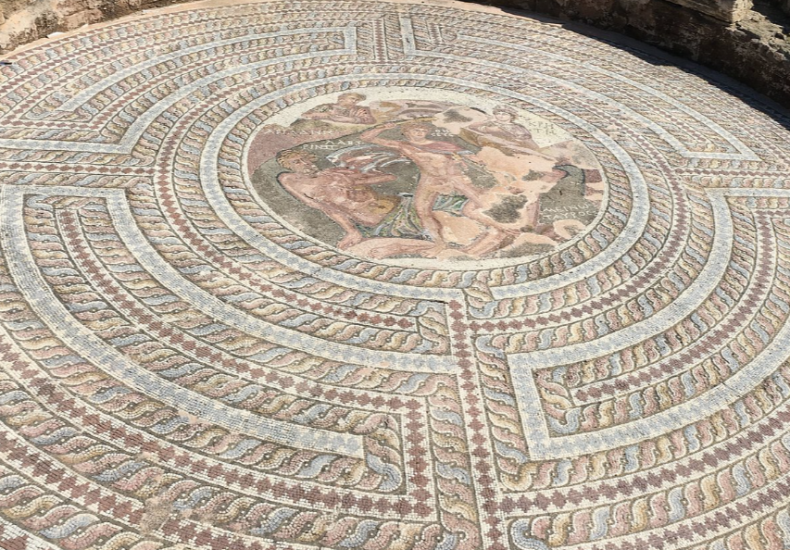
The House of Dionysus in Paphos: Experiencing Ancient Cyprus
Cyprus is deservedly known as the island of gods and ancient myths, where past and present seamlessly blend, creating an extraordinary atmosphere. One of the key historical treasures of this island is undoubtedly the House of Dionysus, located at the heart of the Kato Paphos Archaeological Park. This site captivates visitors from all corners of the globe with its rich history and artistic masterpieces, narrating intriguing tales of past civilizations.
Historical Background and Significance
The House of Dionysus came to light quite by chance in 1962, when a local farmer unexpectedly uncovered ancient mosaics during routine agricultural work. This surprising find triggered significant archaeological efforts, leading to the discovery of an outstanding Roman villa dating approximately from the 2nd to the 3rd century AD.
The villa was named “House of Dionysus” because of the prominent central mosaic dedicated to Dionysus, the Greek god of wine and festivity. The site is particularly famous for its exceptionally well-preserved mosaic floors, considered among the finest in the Mediterranean region.
Unique Mosaics: Artistic Wonders
The primary attraction of the House of Dionysus lies in its astonishing mosaics, crafted with remarkable precision. Composed of countless tiny stones (tesserae), these mosaics vividly depict mythological scenes, daily life, and nature.
Some notable mosaic scenes include:
- The Triumph of Dionysus – a magnificent depiction of Dionysus accompanied by satyrs and maenads in a festive procession. The expressiveness and detail in the faces are truly remarkable.
- Pyramus and Thisbe – a moving representation of tragic love from ancient mythology, which inspired Shakespeare’s play “Romeo and Juliet.”
- Narcissus – a beautifully detailed portrayal illustrating the legend of a youth who fell in love with his reflection.
Each mosaic is a unique masterpiece, immersing visitors deeply into ancient cultural narratives.
Architectural Highlights
The House of Dionysus exemplifies traditional Roman architecture, reflecting the luxurious lifestyles enjoyed by affluent individuals during that era.
Key architectural features of the villa include:
- A spacious central atrium surrounded by leisure and social rooms.
- An inner courtyard with gardens offering cool and peaceful settings.
- Rooms decorated with elaborate mosaic panels signifying the homeowner’s wealth and status.
The building’s architecture clearly demonstrates Roman influences, showcasing sophisticated construction techniques and exquisite design standards of its time.
Tips for Visitors
To enhance your visit to the House of Dionysus, consider the following practical suggestions:
- Visit in the morning – early hours are ideal to avoid heat and crowds.
- Comfortable clothing and footwear – ensure comfortable walking shoes and clothing, including sun protection such as hats and sunscreen.
- Guided Tours – hiring a professional guide or audio guide greatly enriches your visit with insightful historical context and anecdotes.
- Photography – take pictures without flash and follow staff guidelines to protect these invaluable artworks.
Emotional Connection with History
Exploring the House of Dionysus is more than mere sightseeing—it’s an emotional journey into the past. Wandering through its halls, one can vividly imagine ancient laughter, feasts, and celebrations dedicated to the gods.
Observing these timeless mosaics evokes feelings of awe and admiration, connecting visitors emotionally with the creativity and skills of ancient artisans. Each artwork serves as a bridge between past and present, reminding us of humanity’s enduring pursuit of beauty and expression.
Educational Importance
The House of Dionysus plays a crucial role in both tourism and education, serving as a significant learning site for students and scholars:
- Regular archaeological and historical research conducted here continuously expands understanding of Roman culture.
- Frequent school and university tours allow younger generations to actively learn about history and archaeology firsthand.
Thus, the villa is not just an ancient relic but a dynamic educational resource.
Reasons to Visit the House of Dionysus
If you’re considering including this site in your Cyprus itinerary, here are compelling reasons why it’s worth your time:
- Unique mosaics renowned for their excellent condition and artistic quality.
- An opportunity to experience nearly two millennia of history.
- Engaging emotions and aesthetic pleasure from viewing these ancient artworks.
Conclusion
The House of Dionysus in Paphos is truly a gem of Cyprus’s archaeological heritage. It inspires visitors, fuels their imagination, and leaves lasting impressions. Visiting this site not only enriches your understanding of ancient civilizations but also allows you to experience the incredible energy preserved in every mosaic and stone.
May your visit become an unforgettable journey through time, filled with beauty, knowledge, and inspiration.